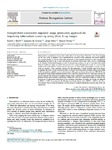Mostrar o rexistro simple do ítem
Unsupervised contrastive unpaired image generation approach for improving tuberculosis screening using chest X-ray images
| dc.contributor.author | Iglesias Morís, Daniel | |
| dc.contributor.author | Moura, Joaquim de | |
| dc.contributor.author | Novo Buján, Jorge | |
| dc.contributor.author | Ortega Hortas, Marcos | |
| dc.date.accessioned | 2022-12-19T19:39:50Z | |
| dc.date.available | 2022-12-19T19:39:50Z | |
| dc.date.issued | 2022-12 | |
| dc.identifier.citation | D. I. Morís, J. de Moura, J. Novo, y M. Ortega, «Unsupervised contrastive unpaired image generation approach for improving tuberculosis screening using chest X-ray images», Pattern Recognition Letters, vol. 164, pp. 60-66, dic. 2022, doi: 10.1016/j.patrec.2022.10.026. | es_ES |
| dc.identifier.issn | 0167-8655 | |
| dc.identifier.uri | http://hdl.handle.net/2183/32221 | |
| dc.description.abstract | [Abstract]: Tuberculosis is an infectious disease that mainly affects the lung tissues. Therefore, chest X-ray imaging can be very useful to diagnose and to understand the evolution of the pathology. This image modality has a poorer quality in contrast with other techniques as the magnetic resonance or the computerized tomography, but chest X-ray is easier and cheaper to perform. Furthermore, data scarcity is challenging in the domain of biomedical imaging. In order to mitigate this problem, the use of Generative Adversarial Network models for image generation has proved to be a powerful approach to train the deep learning models with small datasets, representing an alternative to classic data augmentation strategies. In this work, we propose a fully automatic approach for the generation of novel synthetic chest X-ray images to mitigate the effect of data scarcity in order to improve the tuberculosis screening performance using 3 different publicly available representative datasets: Montgomery County, Shenzhen and TBX11K. Firstly, this approach trains image translation models with a large-sized dataset (TBX11K). Then, these models are used to generate the novel set of synthetic images using small-sized and medium-sized datasets (Montgomery County and Shenzhen, respectively). Finally, the novel set of generated images is added to the training set to improve the performance of an automatic tuberculosis screening. As a result, we obtained an 88.41% 5.27% of accuracy for the Montgomery County dataset and a 90.33% 1.41% for the Shenzhen dataset. These results demonstrate that the proposed method outperforms previous state-of-the-art approaches. | es_ES |
| dc.description.sponsorship | ISCIII; DTS18/00136 | es_ES |
| dc.description.sponsorship | Ministerio de Ciencia e Innovación y Universidades; RTI2018-095894-B-I00 | es_ES |
| dc.description.sponsorship | Ministerio de Ciencia e Innovación; PID2019-108435RB-I00 | es_ES |
| dc.description.sponsorship | CCEU, Xunta de Galicia; ED481A 2021/196 y ED481A 2021/196 | es_ES |
| dc.description.sponsorship | Xunta de Galicia; ED431C 2020/24 | es_ES |
| dc.description.sponsorship | Agencia Gallega de Innovación (GAIN), Xunta de Galicia; IN845D 2020/38 | es_ES |
| dc.description.sponsorship | Receives financial support from CCEU, Xunta de Galicia, through the ERDF (80%) and SXU (20%). | es_ES |
| dc.description.sponsorship | Funding for open access charge: Universidade da Coruña/CISUG. | es_ES |
| dc.description.sponsorship | CITIC; ED431G 2019/01 | es_ES |
| dc.language.iso | eng | es_ES |
| dc.publisher | Elsevier | es_ES |
| dc.rights | Atribución-NoComercial-SinDerivadas 3.0 España | es_ES |
| dc.rights.uri | http://creativecommons.org/licenses/by-nc-nd/3.0/es/ | * |
| dc.subject | Tuberculosis | es_ES |
| dc.subject | Chest X-ray | es_ES |
| dc.subject | Deep learning | es_ES |
| dc.subject | Biomedical imaging | es_ES |
| dc.subject | Contrastive unpaired translation | es_ES |
| dc.subject | Data scarcity | es_ES |
| dc.title | Unsupervised contrastive unpaired image generation approach for improving tuberculosis screening using chest X-ray images | es_ES |
| dc.type | info:eu-repo/semantics/article | es_ES |
| dc.rights.access | info:eu-repo/semantics/openAccess | es_ES |
| UDC.journalTitle | Pattern Recognition Letters | es_ES |
| UDC.volume | 164 | es_ES |
| UDC.startPage | 60 | es_ES |
| UDC.endPage | 66 | es_ES |
Ficheiros no ítem
Este ítem aparece na(s) seguinte(s) colección(s)
-
GI-VARPA - Artigos [79]






